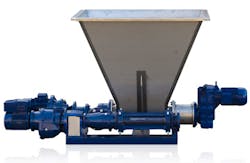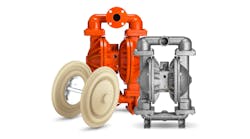Most food plants generate by-products, particularly if engaged in primary processing, i.e., converting raw materials into finished products. Processors need to remove waste by-products from their production areas as efficiently and hygienically as possible, incur least cost and maximize any potential revenue to be gained.
Traditionally, different removal methods were used, for example, as follows:
- Manual removal using tote bins
- Blown air systems and vacuum systems
- Flumes using water as a transport medium
- Pump waste removal systems
Many processors use combinations of these, often determined by plant layout, previous experience and regulatory demands. However, they all incur high running costs in the form of manual labor, energy use or water treatment. We believe Seepex open-hopper pump waste-removal systems are the exception.
Chopping with pumping
These units incorporate a progressive-cavity pump capable of moving both high and low viscosity products, with and without solids. For most applications, a design patented pump which can chop and pump food waste with up to 40 percent ds, without added water, is used. These open-hopper BTM range pumps have an auger feed into fixed and rotating knives that can chop most products.
Discarded products, defective raw materials, trimmings and rejects — including overrun — can be handled in a single system, enabling pre-treatment and source segregation of waste and by-products, even when they vary greatly in solids contents and viscosity.
One result is that swiftly proliferating biogas plants can find needed food waste to produce energy. The pumps output liquid slurry that contains no contamination, an ideal feedstock for biogas operations.
In accomplishing this feat, the pumps handle, for example, whole cabbages and wet coleslaw, whole raw potatoes and mashed potatoes, whole chickens and chicken trimmings, in a single multipurpose unit. Efficient and hygienic removal from high-care and low-risk areas is ensured, giving food processors least-cost removal with highest residual value of by-products, as demonstrated by the following case studies.
What they do
Simply Fresh Foods, a division of Morrisons PLC, the fourth largest supermarket chain in the United Kingdom, wanted to move tote-bin traffic from high-care to low-risk areas. The subsequent return of the tote bins proved a hygiene issue. The volume of waste from a vegetable preparation area was high.
Moreover, the factory was expanding to fulfill increased demand for ready prepared vegetables. After installing a hygienic BTM open hopper pump to chop and remove the waste directly from preparation areas, Simply Fresh has a low-volume by-product that is removed directly from production areas without the need for manual movement of tote bins.
Other fruit processors install the pumps with auger feeds into vertically mounted grinders to handle difficult waste from stone fruits, such as mango and peaches. Doing so removes all waste from processing areas, producing slurry which also can be sent to biogas plants for energy generation.
Chicken processors segregate any bird carcasses dead on arrival at processing plants, together with any diseased birds found by inspection. Under some animal by-product regulatory regimes, animal by-products have to be cut and dyed before segregation for rendering, or other further processing, prior to disposal. The PTM pump chops whole chickens, with the addition of dye, before pumping into an enclosed system to the disposal area. This gives customers demonstrable confidence of regulatory compliance.
For pet food
A different unit was provided for a poultry plant in Ireland, to enable entrails to be chopped into a suitable pet-food raw material. This involves an auger feed to a vertical macerator followed by a pump. The entrails are removed directly from the main processing area as slurry, which is then frozen for pet-food use.
Finally, food company Apetito in Wiltshire, England, had a problem with mixed-consistency food waste. It was too liquid to be handled as solid waste, and "not-liquid-enough" for tanker transport. A BTM open hopper pump with an additional macerator ensured a smooth slurry, produced from the mixed ready-meal waste. This high-energy-value waste is now transported in road tankers to a nearby biogas plant, saving transport and waste-disposal costs.
These case studies and many others show how pump systems are a flexible means of removing waste and by-products from food and beverage processing areas without the use of excess energy or added water.
SEEPEX is a leading worldwide specialist in pump technology. Its progressive cavity pumps, macerators and control systems are used wherever low to highly viscous, aggressive or abrasive media must be conveyed at low pulsation rates.


